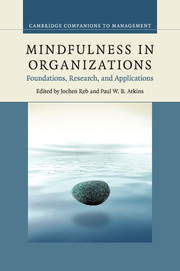Book contents
- Frontmatter
- Contents
- List of figures
- List of tables
- List of contributors
- Foreword
- Preface
- Part I Foundations
- Part II Research
- 6 Mindfulness, identity and work: mindfulness training creates a more flexible sense of self
- 7 Improving decision making through mindfulness
- 8 Mindfulness and creativity in the workplace
- 9 How being mindful impacts individuals' work-family balance, conflict, and enrichment: a review of existing evidence, mechanisms and future directions
- 10 Building and maintaining better leadership relationships through mindfulness
- 11 Leading with mindfulness: exploring the relation of mindfulness with leadership behaviors, styles, and development
- 12 Mindfulness in interpersonal negotiations: delineating the concept of mindfulness and proposing a mindful, relational self-regulation (MRSR) model
- 13 Drawing the line: sketching out the role of visual templates in individual mindfulness and mindful organizing
- Part III Applications
- Index
- References
11 - Leading with mindfulness: exploring the relation of mindfulness with leadership behaviors, styles, and development
from Part II - Research
Published online by Cambridge University Press: 05 July 2015
- Frontmatter
- Contents
- List of figures
- List of tables
- List of contributors
- Foreword
- Preface
- Part I Foundations
- Part II Research
- 6 Mindfulness, identity and work: mindfulness training creates a more flexible sense of self
- 7 Improving decision making through mindfulness
- 8 Mindfulness and creativity in the workplace
- 9 How being mindful impacts individuals' work-family balance, conflict, and enrichment: a review of existing evidence, mechanisms and future directions
- 10 Building and maintaining better leadership relationships through mindfulness
- 11 Leading with mindfulness: exploring the relation of mindfulness with leadership behaviors, styles, and development
- 12 Mindfulness in interpersonal negotiations: delineating the concept of mindfulness and proposing a mindful, relational self-regulation (MRSR) model
- 13 Drawing the line: sketching out the role of visual templates in individual mindfulness and mindful organizing
- Part III Applications
- Index
- References
Summary
Introduction
A recent Forbes article stated that “Mindfulness is hot right now – Hollywood hot, Davos hot, Main Street hot … For business leaders, encouraging mindfulness is more than just being tuned in; it's a strategy to improve person and company-wide performance and productivity” (Bruce 2014). Leadership is a perennially trendy topic, and its fusion with mindfulness creates a combination of potential über-trendiness. But is this hype justified? Our endeavour in this chapter is to elaborate on the connections between mindfulness and leadership. A related goal is to take a critical look: generally both mindfulness and leadership are viewed in a positive light. Although “leadership” evokes ideas of strengths and charisma, transformation, and achievement. Yet at the same time, a “dark side” of leadership and leaders also surfaces in the form of leader arrogance, hubris, cronyism, abusive supervision, and outright dictatorships.
Perhaps even more so than with leadership, mindfulness appears to be seen as almost universally positive. Indeed, a large number of studies have found beneficial effects of mindfulness for, among others, individual health, psychological wellbeing, and functioning (Chiesa and Serretti 2010; Eberth and Sedlmeier 2012). Also, as shown in the various chapters of this book and other work, a strong case can be made that mindfulness and mindfulness practice have substantial potential to improve the quality and outcomes of work life (see also Glomb et al. 2011). Finally, empirical research on the effects of leader mindfulness provides evidence of beneficial consequences for employees including increases in employee job performance, job satisfaction, and need satisfaction, and reductions in emotional exhaustion (Reb, Narayanan, and Chaturvedi 2014).
Although we are in broad agreement with claims regarding the benefits of mindfulness in general and for leadership in particular, at the same time, one can wonder whether there are any downsides to leaders being mindful.
- Type
- Chapter
- Information
- Mindfulness in OrganizationsFoundations, Research, and Applications, pp. 256 - 284Publisher: Cambridge University PressPrint publication year: 2015
References
- 25
- Cited by



